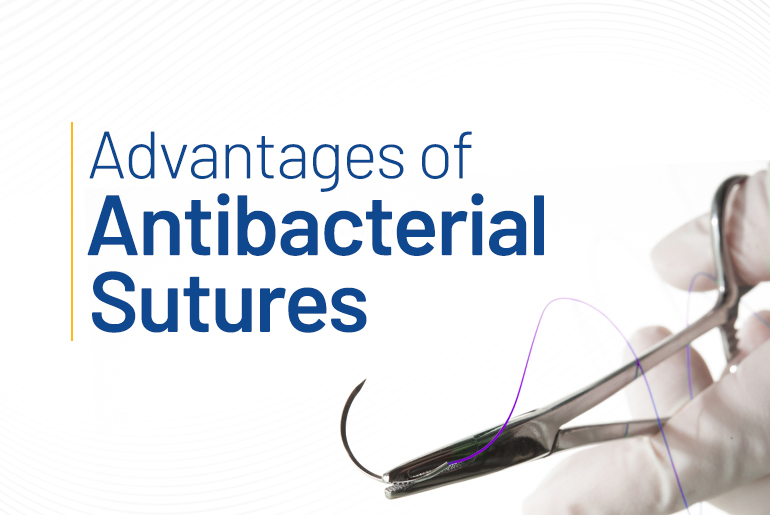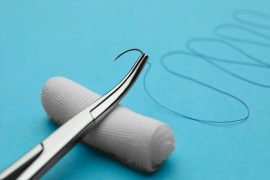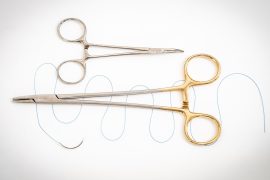Wounds can be extremely painful. These wounds can also pose a health risk if they become inflamed or infected. The cause of the suture getting infected could be bacteria, especially those that are naturally found on the skin and Atmosphere. Thus, wound closure may end up promoting bacteria proliferation which can lead to wound complications. As a result, operating doctors, nurses, and other medical professionals have created ways to reduce surgical site infection, speed up healing, and prevent any of these healthcare-associated infections (HCAIs) and surgical site infections (SSIs) from spreading further. One of the ways they have done this is by using antibacterial sutures (ABS) in wound. This closure procedures article explores the advantages of using antibacterial sutures in wound closure procedures. There are various ways and techniques to treat wounds – sutures, staples, non-surgical medications, etc.
What Is a Suture?
A suture, also known as a stitch, is a very thin, long thread that is twisted together to form a single strand in case of braided structure or comprises of single thread called Monofilament. Suturing is a method of tying off blood vessels to prevent bleeding and hold a wound together till the natural healing process is sufficiently established.
What is an Antibacterial Suture?
Any wound, by and large, are may get contaminated at the time of closure. As a solution to this problem, an antibacterial suture is a surgical innovation which reduces the risk of Surgical Site Infection (SSI). Antibacterial sutures are coated with Antibacterial agents and other agents containing antibacterial properties. They may help in healing wounds faster by significantly reducing the risk of surgical site infections. Why do you need to use an antibacterial suture? We need to use antibacterial suture because bacteria are the leading cause of many types of infections in wounds. You can prevent these infections by covering the wound surfaces with a substance that kills them. An antibacterial suture (Absorbable) is a prosthetic implant into the wound, making it impossible for the bacteria to grow on the surface. You may then cover the wound with a bandage.
Types of Wounds that Can Use Antibacterial Sutures
The first thing you should know about using antibacterial sutures in wound closure procedures is that they can be used on various types of wounds. Antibacterial sutures can be used
- To close the skin tissue after the surgical procedure
- To Ligate blood vessels during the planned surgical procedures
In this case, we are referring to regular cuts and injuries & suturing is done in a sterile atmosphere.
How an Antibacterial Suture works ?
Ordinary sutures may pose a risk of infection if required OT Protocols are not followed. Sometimes, an already sutured wound can rupture and burst open if the healing is not complete – this happens due to bacterial infection. If a wound is not sutured correctly, this is an additional complication and cosmetic loss. The Antibacterial coating on the Antibacterial sutures acts as an additional shield against the bacterial growth.
Advantages of using an Antibacterial suture
The layperson needs to know why a surgeon uses an antibacterial or antimicrobial suture technology in their clinical practice. There is enough evidence and data in surgical studies and peer-reviewed journals that an antibacterial suture is a huge clinical benefit. It has a purpose in its design to add value to risk reduction strategies for any SSIs.
- Prevents Infection – One of the main advantages of using an antibacterial suture is that it prevents infections in a wound. Bacterial infections can be very dangerous. If they go untreated, they can lead to sepsis. Sepsis is an extreme form of blood poisoning that is very dangerous and can quickly lead to death. Preventing these infections means less chance of them spreading throughout your body and causing severe health complications.
- Patient Safety – Antibacterial sutures contribute significantly to patient safety by reducing microbicidal activity, which can be both internal and external, enhancing clinical effectiveness and being cost-effective. Antibacterial coated sutures create a Zone of Inhibition around the suture site preventing Bacterial colonization. Hence, antibacterial sutures become the need of the hour to reduce bacterial adherence to surgical sutures.
- Effective Results – As an invasive innovative technology, antibacterial sutures have stood the test of time ever since they were introduced in the early 1990s. Since their introduction and usage in wound closures, there has been significantly less wound dehiscence, delayed healing, emergence of resistant organisms, toxicity, or allergic reactions.
- Economically viable – In paediatric and adult surgical procedures, antibacterial suture technology is economically effective and viable. The patient’s Length of Stay may reduce due to the wound being closed with the help of Antibacterial sutures. An added advantage of Antibacterial coating helps in preventing bacterial growth along the line of suture thus preventing unpredicted wound healing.
Conclusion
Globally recognized health authorities like the Centers for Disease Control and Prevention (CDC), the World Health Organization (WHO), and the American College of Surgeons & Surgical Infection Society (ACS & SIS) have recommended the use of antibacterial sutures like triclosan-coated sutures to prevent surgical site infection (SSI). Their guidelines on reducing the risk of SSI are general to antibacterial triclosan-coated sutures, not specific to any one brand. Also, using ABS for skin closure in surgical patients displayed a reduced risk of developing surgical site infections and postoperative complications.





Comments are closed.